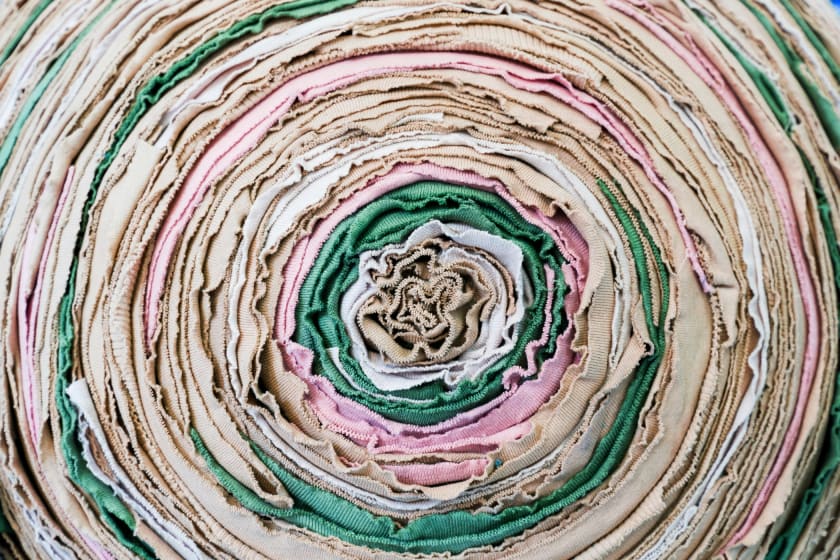5 Uses of Recyclable Cotton



Cotton is the most widely used fabric for apparel globally, yet its manufacture has a significant environmental impact, notably on water supplies. Indeed, cotton manufacturing is responsible for the extinction of virtually an entire sea! Among the other significant difficulties associated with cotton, cultivation is the use of polluting pesticides and chemicals to preserve crops, as well as land clearing.
As global consumerism expands, worsened by the emergence of fast fashion, an increasing number of habitats suffer irreversible harm. Something has to change.
As consumers, we have a lot of options for reducing our reliance on cotton. One way is to purchase fewer, higher-quality garments and cotton items, as well as purchasing secondhand or reusing. Another option is to purchase goods manufactured from organic cotton that has not been treated with toxic chemicals or pesticides. A third involves purchasing products created from recycled cotton.
Cotton fabric recycling may be broadly described as the process of turning cotton fabric into cotton fibre that can be used in textile goods. This repurposes the object, diverting it away from landfills and incinerators.
What is the manufacturing process for recycling cotton?
Cotton that has been recycled is gathered from industry or consumer trash. After sorting items by category and colour, they are shredded into smaller bits and finally into crude fibre by a machine. It may then be spun again into yarn and used as another product.
Shredding the cloth into its simplest forms is a demanding task. This degrades the new fibre's quality, making it shorter and more difficult to spin. As a result, the new fibres are combined with existing virgin materials, such as plastic or cotton, to increase their strength and recyclability.
Is Recycled Cotton a Sustainably Produced Material?
As one might expect, the regenerated cotton yarn has a far lower environmental effect than ordinary cotton yarn. A clear advantage of recycling cotton is that pure recycled cotton is biodegradable, which eliminates concerns about a long-term impact on the environment, as is the case with recycled polyester.
If you're looking for a natural, ecological fabric that isn't made of synthetic fibres, recycled cotton is an excellent choice.
How Is Cotton Yarn Made from Recycled Cotton?
Cotton recycling is not usually a straightforward procedure; chemical, mechanical, and thermal processing methods are available. Work is still being done to scale the process to make it more convenient and accessible. After obtaining the cotton textile waste, it is separated into textile kinds and colours.
Sorting can be time-consuming, depending on the recycling procedure employed — not only are textiles separated by colour, but special attention must be given to sorting mixed materials.
Numerous cotton fibres are combined with other yarns, limiting the sort of recycling procedure that may be utilised to make new yarn.
After sorting the textile waste, it is shredded or ground into a pulp. Following that, the raw material is handled appropriately for recycling before being spun into fresh yarn.
Due to the challenges inherent incorrectly and effectively selecting second-hand fibres, the bulk of cotton waste recovered originates from production offcuts.
What Is the Purpose of Recycled Cotton?

Recycled cotton is used in a wide variety of products, from household textiles and garments to industrial cleaning cloths and even paper.
Cotton paper is more durable and of higher quality than wood pulp paper, which is why it is frequently used for banknotes and other essential papers!
Is recycled cotton more environmentally beneficial than ordinary and organic cotton?
While organic cotton farming eliminates the use of synthetic agricultural chemicals such as fertilisers and pesticides and thus represents a significant improvement over conventional methods, it does not address the fact that cotton farming is highly water-intensive and continues to degrade eco-hydrology.
Is Recycled Cotton Long-Lasting?
Recycled cotton yarn can retain its durability or possibly become stronger than virgin cotton, depending on the recycling procedure utilised.
Cotton that has been mechanically recycled loses some of its strength, and thus it is frequently combined with virgin cotton or polyester to guarantee the finished textile is of high quality.
However, when the yarn is recycled chemically, it frequently has better durability and strength than virgin cotton!
There are two basic methods for recovering cotton from textiles:
- Post-industrial or pre-consumer: These are the remnants of yarns and fabrics used to cut and manufacture garments, home textiles, and other fashion accessories.
- Post-consumer: contains clothing, upholstery, towels, and other discarded home goods whose cotton fibres will be recycled to create a new product.
The majority of recovered cotton comes from pre-consumer trash. Post-consumer waste is significantly more difficult to categorise and reprocess due to the range of colours involved, the mix of fibres that make up the fabric, the rest of the raw materials and accessories included in the clothes, and it is a process that requires more labour and is more expensive.
Now let's talk about 5 Uses of recycled cotton.

- Water & Energy Use
It can significantly cut the apparel industry's water and energy use. The amount of water required is less than the amount used to grow and generate virgin cotton.
- Numerous products are diverted from their inevitable and final destination, landfills.
- Recycled cotton can be repurposed in a variety of different elements, some of which are simple to use or require little complexity, such as insulation, mop heads, cleaning rags, and padding.
- Reduced waste
Reduce the amount of textile waste that is disposed of in landfills. A garbage truck containing clothing is projected to arrive at a dump every second. This equates to around 15 million tonnes of textile waste each year. Additionally, 95% of textiles disposed of in landfills might be recycled.
- Conserve water
Reduce the amount of water utilised in the textile manufacturing process by a significant amount. Cotton is a water-intensive plant, and its influence is already being seen, as evidenced by the loss of the Aral Sea in Central Asia.
- Environmentally responsible
We need fewer fertilisers, herbicides, and insecticides when we utilise recycled cotton. Cotton farming is projected to account for 11% of global pesticide usage.
- CO2 emissions are reduced
CO2 emissions and water pollution associated with dyeing are reduced. Textile dyeing is the world's second major source of water pollution, as the waste from this process is frequently thrown in ditches or rivers. Because we are using recycled cotton fibres, there is no need to dye them because the end colour matches the colour of the trash.
Cotton Recycling Benefits:
- It can be used as insulation, rags, or stuffing in areas where it regenerates.
- Recycling eliminates unnecessary waste and diverts a variety of items from landfills. The Council for Textile Recycling estimates that around 25 billion pounds of textile waste are generated annually.
- Because it is already colored, additional colouring is not necessary upon recycling.
- Energy, water, and dyestuff use are minimised since recycled cotton yarns are often supplied from colour-sorted pre-consumer textiles.
- Reduce CO2 and other fossil fuel emissions.
Cotton Recycling's Difficulties:
- Cotton grows weaker during recycling and must therefore be combined with other fibres to create a fresh yarn with the appropriate strength and durability; it cannot be recycled further.
- Any amount of recycled material will affect the yarn and fabric's length, strength, evenness, and uniformity.
- Costs are usually greater than those associated with conventional cotton processing.
- The test findings are not particularly encouraging.
- A maximum of 30% recycled cotton may be utilised in a product.
- Consumer interest in purchasing recycled cotton products at a higher price point is decreasing.
Additionally, recycled cotton must be blended with other fibres, such as (recycled) polyester, to produce a high-quality end product. This is why using current technologies, one will not find pieces made entirely of recycled cotton. While some producers strive for a minimum of 50% recycled cotton content, recycled cotton is still preferable to freshly made textiles if the waste reduction is a primary issue.
Conclusion
In terms of sustainability, recyclable cotton is a hot issue that manufacturers, brands, and retailers are all interested in. For the whole textile supply chain, recycled cotton can be critical to achieving the objective of sustainability. Cotton is the most popular fibre, accounting for around 56% of total fibre consumption worldwide. It delivers consistent high-quality performance since it is adaptable, breathable, and extremely pleasant to wear.
Cotton that has been recycled avoids needless waste and may be a more sustainable option than disposal. It can be derived from recycled garments or from textile waste or leftovers that are subsequently spun into new yarns and fabric. Additionally, it is sometimes referred to as regenerated or recycled cotton.



















